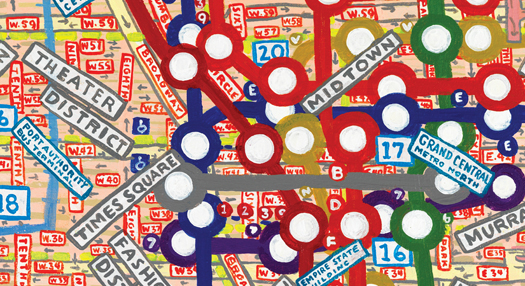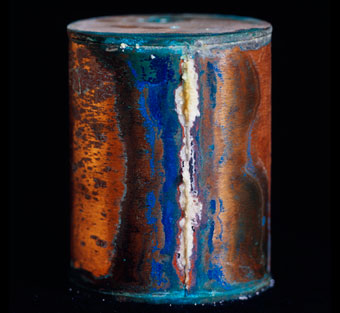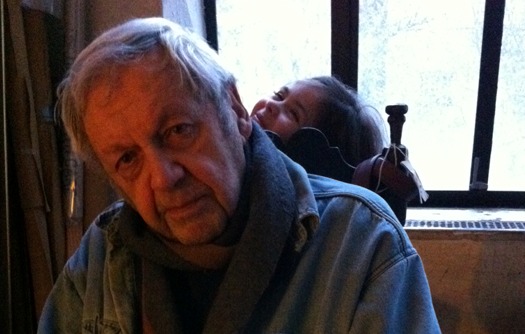
July 1, 2009
Cars R Us
There is poignancy here. The halcyon days are now gone, the golden age of the automobile becoming clear in retrospect (I propose 1956–2009, i.e. from the birth of Interstate highway system to the recent collapse. RIP). These images document the swan song of that era.
Rather than being a nostalgic tribute to our culture’s most characteristic cars (the Ford Mustang, the Buick Electra, the Chevrolet Camaro, the Pontiac GTO, the 1969 Dodge Charger, etc.) these photographs are about something more than technology. They are about our relationship with these machines. Photographed on the open road, using a high powered flash mounted on the door frame of a car and a medium format film camera, these images are surprising in their ability to capture our close involvement with these automobiles, how we have merged with them both physically and emotionally.
These images probe a space that has been relatively undocumented: the private/public space of the car in motion, one of the most intensely personal public spaces in our modern landscape. We can all recall moments of exhilaration, pathos, fear, sex and death experienced in the interior of our cars — the place where we often have our most meaningful conversations, our most catastrophic arguments, and our deepest insights.
These photographs remind us of just how closely connected we have become to these machines, how they have become extensions of our very sense of self (a feeling of identity that the advertising industry has been exploring for years). We have become so close, in fact, that we can hardly see them for what they are — a symbiotic melding of plastic, steel, human flesh and blood (look at the bodies of these cars — pocked and dented and lined they are almost as expressive as our faces). We have made our tools and our tools have made us. It’s been over one hundred years since the combustion engine was first invented and we now eat, drink, talk and die in our cars as naturally as we do in our domestic spaces.
Man traveling southeast at approximately 68 mph on U.S. Route 101 someplace in southern California in the winter of 1997, photo by Andrew Bush
Person driving somewhere in the last decade of the previous millennium (whereabouts unknown), photo by Andrew Bush
There is another reason to admire these portraits; they invite conjecture. We gaze at these anonymous drivers and we wonder where they are going, where they have been, what their lives are like. Unlike photographs of people on the street, or sitting in their homes or offices, there is something about the fact that these subjects have been caught in motion that makes their unresolved narratives especially compelling. They are in media res, in the middle of things, and their frozen moment is more powerful and mysterious as a result.
Have a look at Walker Evan’s Many Are Called, portraits of riders on the New York subway from the late 1930 and early 1940s, and a useful historical precedent. Here faces and bodies are constrained. Their range of emotion is limited; these people can be grim, skeptical or amused but they are in public, surrounded by other passengers and a social formality serves to limit them (in a way that actually seems intriguing).
The subjects of Andrew Bush’s photographs, on the other hand, seem freer and more expressive but they are also appear more alone and anxious. They have gained their autonomy but at what price?
Man traveling southbound at 67 mph on U.S. Route 101 near Montecito, California, at 6:31 p.m. on or around the 28th of a summer month on a Sunday in 1994, photo by Andrew Bush
We all have our personal car stories. Babies put to sleep to the sounds of Radiohead; stolen kisses; accidents miraculously averted. I once met a woman who was going through a difficult divorce. She confessed to me that the only place she felt safe enough to cry was when she was driving alone in her car and traveling at 75 miles an hour. She was very specific about the speed; it had to be at 75 miles an hour — fast enough to feel that she could stay ahead of the other cars on the road, alone and independent and not able to be seen, but not too fast where she could lose control of the car. She’d drive out to the highway, reach 75 mph and, wham, all her pent up rage and pain would come bursting out. She’d cry and weep for hours, cross state lines, and then turn around and come home again, drained and exhausted. She drove a Saab, an irony that was not lost on her.
Adam Harrison Levy is a writer and documentary film-maker. He recently worked on the upcoming BBC2 series, The Genius of Design and produced Selling the Sixties, a BBC documentary about consumerism, advertising and culture of the early 1960s.
With this essay, Design Observer is pleased to announce that Adam Harrison Levy will be joining our regular stable of contributing writers. His previous essays on Design Observer may be found here.
Observed
View all
Observed
By Adam Harrison Levy




